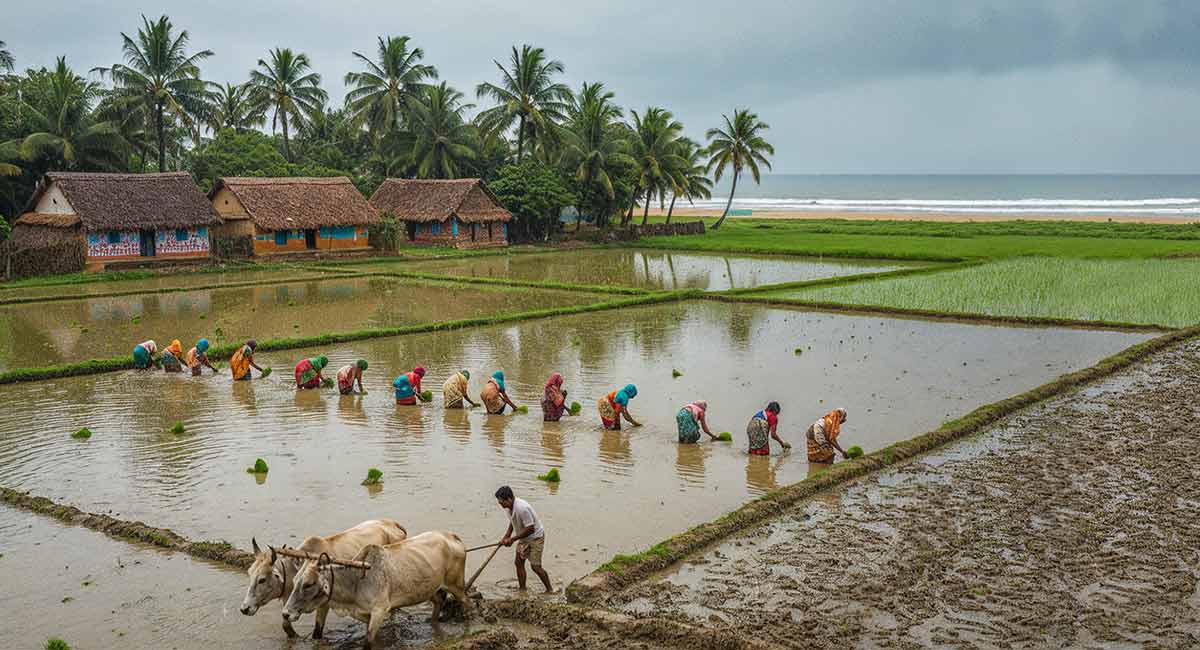Innovative Traditional Farming Methods in Coastal Odisha
Odisha, a coastal state on the eastern edge of India, is often celebrated for its cultural richness, vibrant festivals, and natural beauty. Yet beneath the visible cultural grandeur lies a deeply agrarian society with a time-honored legacy of traditional farming practices, especially in the coastal districts like Puri, Kendrapara, Jagatsinghpur, and Ganjam. The conventional methods, refined over centuries and rooted in ecological wisdom, provide valuable lessons in sustainability, resilience, and community-driven agriculture.
The Landscape of Coastal Odisha
Coastal Odisha is marked by fertile alluvial soil, moderate to high rainfall, and a tropical climate highly conducive to agriculture. Rivers such as the Mahanadi, Rushikulya, and Subarnarekha, along with seasonal streams and creeks, nourish the region. Paddy cultivation dominates the landscape, while pulses, oilseeds, coconut, banana, betel leaves, and vegetables also thrive.
However, the proximity to the Bay of Bengal makes the region vulnerable to cyclones, saline intrusions, and floods. In response, local communities have adapted with resilient and ingenious farming techniques that form the bedrock of traditional agriculture in the region.
- Paddy-Centric Crop Rotation
Rice is more than a staple in Odisha-it is central to its agricultural identity. Traditional farmers practice paddy-based crop rotation to enhance soil fertility and reduce pest outbreaks. After the monsoon paddy harvest (Kharif season), many farmers grow pulses like green gram (moong) or black gram (urad) during the Rabi season. This rotation naturally replenishes nitrogen in the soil, thanks to the nitrogen-fixing properties of legumes.
This low-input practice enhances long-term soil health, reduces dependency on chemical fertilizers, and ensures food and nutritional security.
- Use of Indigenous Seeds
One of the most defining aspects of traditional farming in coastal Odisha is the reliance on indigenous seed varieties. Unlike hybrid seeds, which often demand specific chemical inputs and irrigation patterns, local varieties naturally match the regional climate and soil.
Examples include:
- Kandagiri Dhan is known for its flood tolerance.
- Lalat – a fine-grained rice favored for festivals.
- Kalajeera – a fragrant rice often called the ‘black pearl’ of Odisha.
Families pass down seed-saving practices through generations. Farmers exchange seeds within the community during festivals or village seed fairs, strengthening communal ties and preserving genetic diversity.
- Indigenous Irrigation Systems
Despite the region’s heavy reliance on monsoons, traditional irrigation techniques ensure water conservation and efficiency. Coastal Odisha has a legacy of canal systems and rainwater harvesting ponds (pokhari) built collectively by villages.
The traditional ‘Mund’ system-a type of earthen embankment-diverts water to paddy fields. In many places, people create small check dams and temporary bunds using bamboo and mud to store water during the dry season. These time-tested irrigation systems are low-cost, community-managed, and effective in maintaining year-round productivity.
- Mixed and Multi-Cropping Systems
Farmers in coastal Odisha often practice mixed cropping, combining cereals, legumes, oilseeds, and vegetables in the same field. For instance, paddy fields are bordered with pulses or vegetables, providing a dual harvest. In home gardens or backyard farms (locally called bari), bananas, coconuts, papaya, turmeric, and medicinal herbs grow side-by-side.
These multi-cropping systems make the most use of available land while lowering the chance of crop loss from pests or climate change. The approach mimics natural ecosystems, promoting biodiversity and reducing the need for external inputs.
- Organic Inputs and Natural Pest Control
Chemical fertilizers and pesticides are a relatively modern introduction. Traditionally, farmers relied on cow dung, green manure (like sunhemp), and composted kitchen waste to maintain soil fertility. Ash from wood-fired stoves and neem leaves serve as natural pesticides. Widespread local practice is “handi pani,” a fermented liquid from cow dung, cow urine, jaggery, and water. It is sprayed on crops to enhance growth and ward off pests. This organic approach ensures that the land remains fertile and chemical-free, while keeping farming costs low.
- Betel Leaf Cultivation in Coastal Belts
In districts like Jagatsinghpur and Puri, betel leaf farming (paan chasa) is a specialized traditional agricultural practice. Farmers build “bareis”—thatched enclosures made of coconut leaves and bamboo-to create humid microclimates for betel vines.
Betel cultivation is labor-intensive and deeply rooted in social structures, often involving entire families. People sell the leaves across India and have preserved the practice for generations, showcasing the skill and patience required in traditional horticulture.
- Community-Based Farming and Knowledge Sharing
Traditional farming in Odisha is not just a solitary endeavor but deeply communal. Practices like “Gotia” or cooperative labor, where neighbors help each other during peak farming activities like sowing and harvesting, still exist in many rural areas.
Elderly farmers serve as custodians of traditional knowledge, offering guidance on seasonal variations, pest signs, moon-phase planting, and rituals to appease nature’s forces.
- Cultural and Ritualistic Integration
Farming in Odisha is interwoven with cultural rituals and festivals. Nabanna (new rice harvest festival), Raja Parba (celebrating womanhood and agriculture), and Makara Sankranti (harvest festival) showcase gratitude to the Earth and reinforce the spiritual connection between humans and farming.
Farmers perform rituals like “Akhi Muthi Anukula” even before sowing seeds to invoke blessings for a good harvest. These traditions serve spiritual and ecological purposes, reminding farmers of their duties to the land.
Final Thoughts
As modern agriculture grapples with ecological degradation, climate change, and market dependency, the traditional farming methods of coastal Odisha offer powerful alternatives rooted in local resilience, biodiversity, and low-input sustainability. These practices have withstood the test of time, not through technological interventions, but through an intimate understanding of nature.
To ensure food security and ecological balance, it is essential to document, preserve, and integrate these traditional methods with modern innovations. Supporting local farmers, investing in indigenous seeds, and recognizing the cultural importance of agriculture can pave the way for a more holistic and sustainable farming future.


